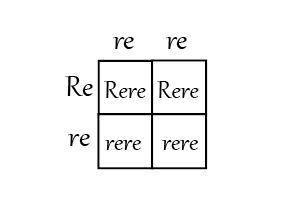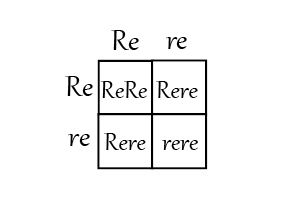
HRat Genetics eading 1G
One doesn't need to become an expert on genetics to breed. But understanding the basics of how genetics work is important. It is the difference between understanding what you are working with and pairing together vs just randomly tossing rats together and hoping for the best.
Learn and understand the basics of how genetics work, dominant and recessive genes and what the genes are you are working with.
Genetics can be intimidating at first and you may be overwhelmed. It isn't that simple and easy, it can take time and effort to really understand. But it is not impossible! It can all seem like gibberish at first but if you just think of it like matching letters with a name, it doesn't seem so bad. I have some methods that greatly help to learn.
1. Write notes. Get a notebook that you can carry around your rats and computer and everywhere else and write detailed notes as well as just jot down short notes and the genetic codes. Writing everything out in your own words as if you were explaining it to someone else is very helpful.
2. Make flashcards using index cards! Write the codes on one side and the description on the back. You can test yourself or have someone help quiz you!
3. Use the codes often. Just bang it through your stubborn head until it sticks!
I give all of my rats an ID #, each line has the genetic code in it. So my Siamese line is #chch, my black line is #aa, etc...
You can also write out the codes for what you work with and put them on index cards and tape them up on the walls around the rat room. Or be all fancy and creative and go get a poster board and make a pretty poster to hang up! You can be creative and have fun with it!
Terminology
Alleles - An allele is a variant form of a given gene. Rats inherit an allele from each parent and they can be Dominant or Recessive. These make up the genetic codes we use such as aa for black, AA for agouti.
Chromosome- a threadlike structure of nucleic acids and protein found in the nucleus of most living cells, carrying genetic information in the form of genes. Humans have 46 chromosomes, we get 23 from each parent. 22 of these are the same in both sexes, and the other is responsible for our sex. Rats have a total of 42 chromosomes, 21 from each parent and like us one being responsible for their sex.
DNA - deoxyribonucleic acid, a self-replicating material which is present in nearly all living organisms as the main constituent of chromosomes. It is the carrier of genetic information. The fundamental and distinctive characteristics or qualities of someone or something, especially when regarded as unchangeable.
Locus - (loci) a fixed point on a chromosome. This is the position of each trait.
Genes come in pairs, called alleles, and each pair is located in a specific position (or locus) on a chromosome.
Mutation - A mutation is an inheritable change in an organism's DNA that ultimately serves as a source of genetic diversity. All of the colors, markings, ear shapes, etc... were caused by a mutation.
Genotype - is the genetic makeup of the individual.
Phenotype- this is the observable characteristics of an individual
Explaining Genotype vs Phenotype
This can often be confusing for new breeders. The genotype is what the rat actually is genetically while the phenotype is what the rat appears to be. Most standards are based on the phenotype. Let me give an example:
I have a Marked Wedge Blaze Siamese rat. Genetically they are Siamese. But after they molt because of the Wedge Blaze they will not have any points! They will look like a pure white rat, an albino or PEW. If you didn't know the pedigree and only saw it as an adult, you would think it was an albino. There would be no reason for you to assume or know that it was a Siamese. Their phenotype could be a PEW, their genotype is Siamese. This is important to know for breeding.
So quite often when it comes to breeding we might have to test by breeding to see what the actual genes are involved! Don't judge a book by its cover I guess!
Homologous - (Homo) Means the same. This is when a rat has two copies of the same allele (aa)
Heterozygous - (Het) Means different. This is when there are two different alleles. (Aa)
If the two alleles at a locus are identical to each other, they are homozygous; if they are different from one another, they are heterozygous.
Dominant - When a gene is dominant it only needs 1 copy of the gene to express. It can not be carried. It is represented by an uppercase letter such as A for agouti.
Recessive - When a gene is recessive it needs 2 copies, one from each parent to express. It can be carried and not show. It is represented by a lower case letter such as aa for black.
An easy way to remember is to imagine the uppercase letter towering over the lowercase letter. The poor little letter is blocked out by the uppercase letter's shadow! So the uppercase letter is expressed and shows on the phenotype.
So remember, each allele is a pair. This pair can either be homo or hetro. Let's use Black and Agouti as examples. Agouti is dominant it is represented by an uppercase A. Black is recessive so it is represented by a lowercase a.
We have 3 rats what would they be?
AA - is homo agouti (has two agouti genes). The rat is Agouti.
Aa - is hetro agouti (has one agouti gene and one black gene). This rat's phenotype is Agouti.
aa - is homo black (has two black genes). This rat is Black.
Expressed - this is when a gene is shown in the rat's phenotype. A rat needs 1 copy of a dominant gene to express it and needs 2 copies of a recessive gene to express it.
Carried - when a rat carries a gene it means the rat inherited a recessive gene from a parent. Only recessive genes can be carried.
So if I say a rat carries the recessive dumbo gene, it would mean they have standard ears but inherited the gene for dumbo. If they were bred to another rat that also carried the dumbo gene their offspring would have the chance to get two copies of the dumbo gene and then express dumbo ears. And then that baby would have dumbo ears!
Hidden genes- this is when a dominant gene is "covered" by something else or is lacking something needed for it to show. This can be a bit confusing. The rat does have the gene, but for whatever reason, it is not being expressed.
Some notable examples would be something like Burmese, which only shows with C Locus. So the rat has the Burmese gene but not the C locus to express it. Another is Pearl which requires mink to express.
Funny enough, this has been a familiar issue to me. I had the Downunder marking, which is dominant. The litter of babies gave me many self or undermarked Irish babies that were covering up and hiding the Downunder marking from showing. Well wasn't I shocked when these babies gave me litters with Downunder babies! How can this dominant gene be in these babies when the parents weren't?! Well, the parents were Downunder, you just couldn't tell by their phenotype. It actually happened to me again with Pearl! This is not a highly common occurrence but is possible.
Let's step up just a smidge from the basics!
Co-Dominanance & Incomplete Dominance -
In both codominance and incomplete dominance, both alleles for a trait are dominant. In codominance a heterozygous individual expresses both simultaneously without any blending. An example of codominance is the roan cow which has both red hairs and white hairs. In incomplete dominance a heterozygous individual blends the two traits. An example of incomplete dominance is the pink snapdragon, which receives a red allele and white allele. -source
The Rex gene (Re) is an example of Incomplete Dominance. When you have Rex X Rex (ReRe) it creates Double Rex.
Hypostatic gene - A hypostatic gene is one whose phenotype is altered by the expression of an allele at a separate locus. These genes are often found in relation to the C Locus such as Burmese or Black Eyed Gene.
Lethal Allele - Lethal alleles are alleles that cause the death of the organism that carries them.
If a rat has homo allele of certain genes this will cause death in utero. That means that if a rat inherits two copies of specific genes the fetus will be absorbed in the womb. There are a few genes suspected of being lethal. Pearl is for sure.
Modifier - these genes affect the expression of other genes. We deal with modifiers a lot in markings. They are often represented by using parentheses ().
Punnett Square - The Punnett square is a square diagram that is used to predict the genotypes of the offspring from a pairing.
Generally, a Punnett square is used to try and determine the outcome of a litter. To the right is an example of a Punnett Square for two rats.
The Mother is Rex (Rere - one copy of the dominant rex gene Re and one standard re)
The Father is standard coat (rere)
In this image the mom is represented on the side and the father is represented on the top. Then you just copy the letters from both directions into each box.
Two boxes say Rere and two boxes say rere. What does that tell us?
Well as I explained above, Rere = Rex and rere = standard.
So you can expect the odds to be 50% standard and 50% rex. BUT... the percent are for each individual baby and not the total litter. So it is like each baby flips a coin to determine what they end up as lol.

Now what if we had:
Rex Mother (Rere)
Rex Father (Rere)
One square shows ReRe = Double Rex
Two squares show Rere = Rex
One square shows rere = Standard
So each baby has 25% to be Double Rex, 50% chance to be Rex, and 25% to be standard.

Punnett Squares can be helpful in instances like this when dealing with dominant genes. For recessives, they can tend to be less useful. Unless you really know all that your rats carry it is just kindof hard to say. For example check out AFRMA What if Chart. Pretty much guessing will tell you that you will get a black rat if it is black based and an agouti if it is agouti based! Recessives can be frustrating sometimes!
If you are too lazy to do it on paper they have Punnett Square Calculators as well!
Rat varieties are broken down into different colors,
markings/patterns, coats, as well as size (standard vs dwarf) and tailless.
Ears -
Standard Ear is Dominant
Dumbo is recessive
-
DuDu - Standard Ear
-
Dudu - Standard carrying Dumbo
-
dudu - Dumbo
Next we will move on to colors.....